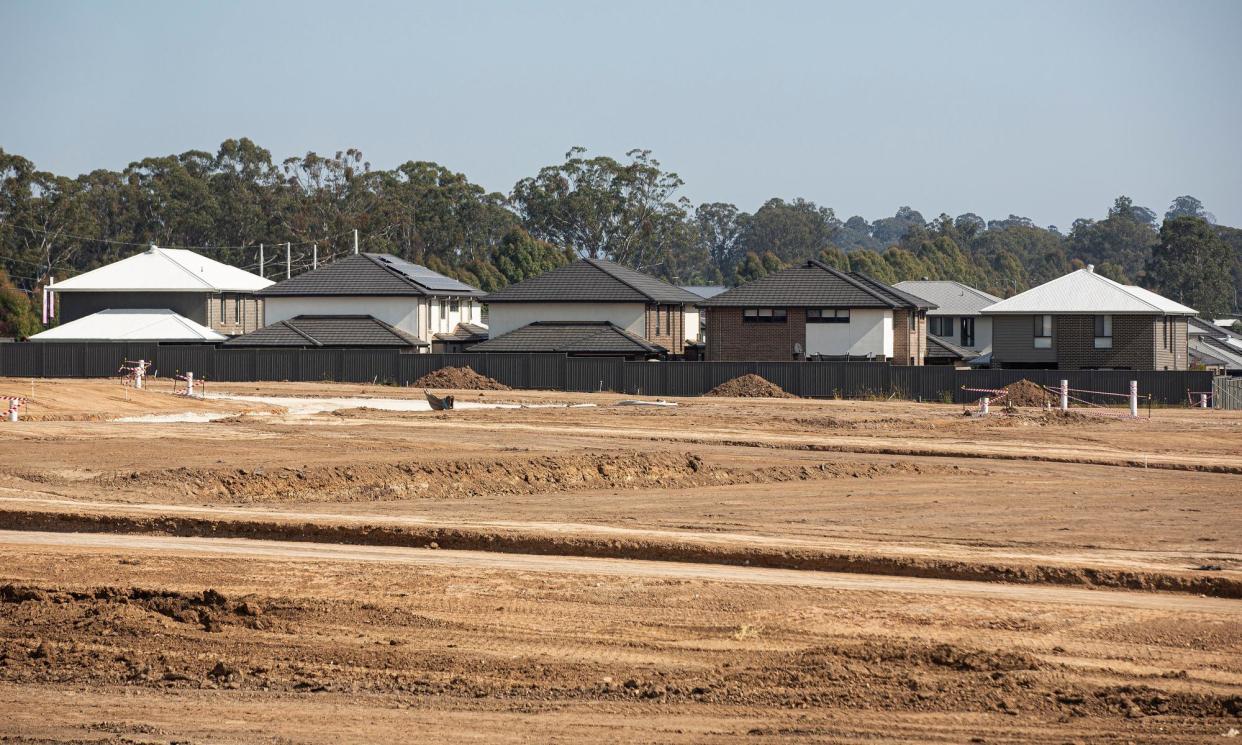Data missing on clearing of endangered ecosystems for western Sydney housing scheme

The New South Wales environment department stopped monitoring and reporting on a $530m conservation program meant to compensate for swathes of land-clearing at the same time as its management of biodiversity offset schemes was under investigation, Guardian Australia can reveal.
Conservationists and the NSW Greens say the government must investigate the “startling failure” by the department to report on progress towards meeting the conservation offset requirements for new suburb developments in western Sydney.
The environment minister, Penny Sharpe, has sought urgent advice from her department about the missing data related to clearing of critically endangered ecosystems for housing in areas including Shanes Park, Riverstone and Schofields.
The data has not been filed by the department for three years. It is an apparent breach of the state’s annual reporting obligations agreed to when the federal government approved the Sydney growth centres, a multi-decade urban development program for western Sydney.
Related: NSW pricing watchdog recommends overhaul of biodiversity offsets scheme
Sharpe, who was in opposition when the department stopped filing the reports, became aware of the issue after Guardian Australia requested to see the documents last week.
“I have asked for urgent advice on what other data and reports might have been delayed under the previous government,” Sharpe said.
The reports track progress towards offset targets for threatened species and ecosystems affected by clearing for new housing and infrastructure in western Sydney. The affected areas include the critically endangered Cumberland plain woodland. The reports also document annual spending on offset credits and conservation areas under the $530m program. Individual transactions under the program can be worth millions of dollars.
The NSW government has not submitted a completed report to the federal environment department or published one since 2019-20, despite being required to do both under its federal obligations.
NSW Greens environment spokesperson Sue Higginson said it was a “shocking omission” and called on the government to investigate.
“These reports are required as part of the state’s obligations under the federal legal framework,” she said. “Considering the parlous state of biodiversity in NSW and the extent of the known failures of the biodiversity offsets system, it’s completely unacceptable.”
The state’s environment department stopped filing the reports during a period in which multiple inquiries, including an auditor general’s review, a parliamentary inquiry and departmental investigations, were under way into the management of the state’s biodiversity offset schemes. The inquiries were triggered in 2021 after Guardian Australia revealed serious failures in the offsets scheme meant to compensate for the clearing of bushland in western Sydney.
Sharpe said she was concerned, and that it was “yet another example of the previous government’s don’t care attitude to the environment”.
The missing conservation reports are for a planning scheme that was designed to guide more than 30 years of housing development in Sydney’s west.
The scheme was approved by the federal government in 2011 under a policy that removed the need for developers to seek individual environmental approval for projects. Instead, it allowed environmental approval to be granted upfront for multiple projects across a mapped region and conservation conditions to be set for the life of the development.
The state government is responsible for meeting the conservation requirements by acquiring conservation lands and buying offsets. Developers contribute to some of the cost by paying a levy.
A NSW environment department spokesperson said the offset program for the growth centres had continued despite its failure to file regular reports. They said the government acquired 10.7ha for conservation in 2020-21 and 98.7ha in 2021-22. They said no offsets were bought under the program in 2022-23, but the government expected to acquire a further 45.67ha this financial year.
Lisa Harrold, the president of the Mulgoa Valley Landcare group, said when the Sydney growth centres were approved the community had hoped it would lead to new nature reserves and corridors to stop the region’s unique ecosystems collapsing. She said transparent reporting on the use of conservation funds was important because it allowed the community to scrutinise whether commitments were being met and where money had been spent.
Related: 'It's an ecological wasteland': offsets for Sydney toll road were promised but never delivered
“Millions of dollars should be invested annually in acquiring land for conservation, but exactly how much funding has been spent and where these offsets are located is a mystery,” she said.
James Trezise, the director of the Biodiversity Council, said the case was a “startling failure” that highlighted the pitfalls of “set and forget” environmental and planning approaches that had been adopted by the federal government over the years.
He said proper environmental oversight was critical in western Sydney, the home of the last remaining patches of Cumberland plain woodland, which provides habitat for species such as koalas, gliders and threatened plants.
The NSW environment department spokesperson said reporting was not a condition of the federal approval for the growth centres but was an obligation under a “procedural agreement” between the two governments. They said the department was working to bring the reporting up to date and publish the missing reports.
A spokesperson for the federal environment department said it had ensured the state government was fully aware of its obligations.


